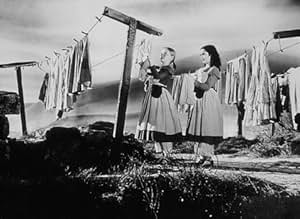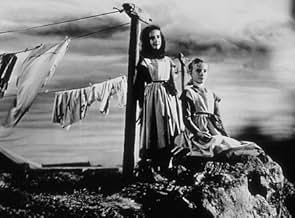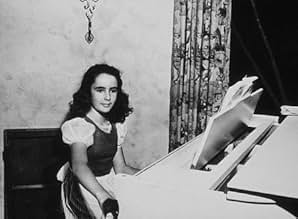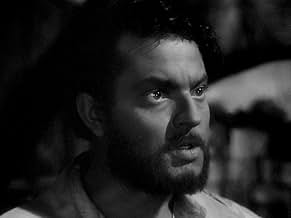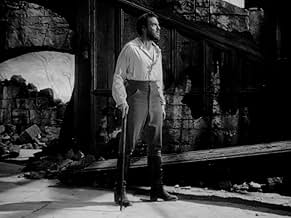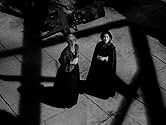अपनी भाषा में प्लॉट जोड़ेंAfter a harsh childhood, orphan Jane Eyre is hired by Edward Rochester, the brooding lord of a mysterious manor house, to care for his young daughter.After a harsh childhood, orphan Jane Eyre is hired by Edward Rochester, the brooding lord of a mysterious manor house, to care for his young daughter.After a harsh childhood, orphan Jane Eyre is hired by Edward Rochester, the brooding lord of a mysterious manor house, to care for his young daughter.
- पुरस्कार
- कुल 3 जीत
- Mason
- (बिना क्रेडिट के)
- Guard
- (बिना क्रेडिट के)
- Bookie
- (बिना क्रेडिट के)
- Townsman
- (बिना क्रेडिट के)
- Woman at Party
- (बिना क्रेडिट के)
- Proprietor
- (बिना क्रेडिट के)
फ़ीचर्ड समीक्षाएं
I had previously reviewed a 1934 version that starred Virginia Bruce and Colin Clive had done for Monogram. And as befit that studio the budget for the project was pretty anemic. And no one could possibly have believed the glamorous Ms. Bruce could be a plain Jane.
Also Joan Fontaine fresh off her Oscar for Suspicion was a far better actress. Fontaine has played glamor roles, but she dialed down the surface beauty to give a finely etched performance as the shy young thing brought up in cruelty by her aunt Agnes Moorehead and schoolmaster Henry Daniell in the institutional school she is sent.
Fontaine is great, but she is also building on the performance of Peggy Ann Garner as the young Jane Eyre who has enough resiliency to overcome a really horrible childhood. In many ways the Garner/Fontaine character of Jane Eyre echo how Joan's sister Olivia DeHavilland as Catherine Sloper was brought up in The Heiress. The miracle is that Jane Eyre doesn't become as twisted as Catherine Sloper.
Orson Welles with his stage training and magnificent voice and pieces of subtlety in his manner scores well as Mr. Rochester who carries a secret tragedy within him. He engages Fontaine to be governess for his 'ward' Margaret O'Brien and love cannot take its course because of some really big barriers. What they are you have to see Jane Eyre for.
I'm sure that 20th Century Fox must have had Suspicion in mind when casting Joan Fontaine. In both films she goes off to live in a big estate a bit apprehensive about what she's getting into. And in both films she has reason to be apprehensive.
One young actress who received no billing, but got real notice was eleven year old Elizabeth Taylor. She plays Peggy Ann Garner's friend in Henry Daniell's school and her death scene must have not left a dry eye in any theater Jane Eyre was playing.
This version of Jane Eyre sets a very high standard for those before or since to follow.
After a harsh and eye opening childhood, orphan Jane Eyre gains employment at Thornfield Hall as governess to the young ward of Edward Rochester. A Difference in class and life outlook, Jane and Rochester are by definition polar opposites, but a bond exists, a bond that surely can't conquer the mysteries of Rochester the man, and the secret of his estate - can it?
Stevenson's version of the often filmed Jane Eyre has been pored over numerous times before, the constant question that arises is that of just how much input and work did Orson Welles have in the production? Knowing what we now know of Welles' 40s output, Jane Eyre undeniably has the Wellesian stamp all over it, with Fontaine herself quoted as saying the big man was often found behind the camera. This is not to decry Stevenson in any way, he himself would carve out a good career in directing further down the line, but this take on Brontë's famous novel shines because of Welles' presence in front and behind the camera.
With that comes one of only two quibbles with the film as a whole, namely it's Welles' portrayal of Rochester that dominates the film, and not that of Fontaine's Eyre. Which is quite staggering considering he doesn't enter the fray until 34 minutes into ty epic. The other problem, naturally, is that with a running time of just over an hour and thirty five minutes, it was never going to be a detailed adaptation of the novel. However, what exists is still an excellent mounted production, a film pulsing with aggressive atmospherics and simmering emotional passions.
It has been argued that the opposing acting styles of Fontaine and Welles are a distraction, I don't see it that way at all, as one of classic cinemas greatest voices emotionally spars with one of its most beautiful faces, this is monochrome gold dust. In mind of the difference of characters as written on the page, it actually comes off as inspired casting. With the production that surrounds them perfectly in keeping with the characters' state of mind.
The look is assuredly what would become known as film noir, with George Barnes' (Rebecca/Spellbound/Force of Evil) vivid black and white photography dovetailing splendidly with the matte paintings and Gothic set designs. It still amazes me to this day that this film was entirely produced on stage 2 at 20th Century Fox. So many images burn into the memory. From the shards of shadows that accompany young Jane as she stands on the punishment stool at Lowood Institution, put there by the despotic Henry Brocklehurst (a menacing Henry Daniell), to each chiaroscuro lit composition of Rochester in and around the oppressive like family home, the film has visual moodiness in abundance.
Herrmann's (The Devil and Daniel Webster/Citizen Kane) score is crucially in tune as well. Orchestral swirls to portray Jane's longing are counter pointed by the menacing down beats that attack the viewer for Rochester's bluster. Away from the two leads it's young Peggy Ann Garner who delivers the most telling performance. She gives the child version of Jane a sorrowful edge that sets the tone of the film, her early scenes with an uncredited Elizabeth Taylor (beautiful and effectively correct in vocals) are a lesson in child acting. The rest of the cast is filled out with admirable performances from Margaret O'Brien (Meet Me in St. Louis), John Sutton (Captain from Castille), Sara Allgood (The Lodger) and Agnes Moorehead (The Magnificent Ambersons).
This may not be a definitive Jane Eyre adaptation, and the compromised ending does knock it down a point, but all told it's still a top piece of classic cinema. 9/10
It's hard to describe which is the most jaw-dropping surprise in this movie: the Kane-esque gothic expressionism of the cinematography, or the stunning acting performances. Welles plays probably the most romantic leading role of his career as the brooding Rochester, while Fontaine postively glows in an understated turn as the title character. Of particular note are two child actors: Peggy Ann Garner, as the young Jane, who has a brief but dazzling turn to open the picture, and who was better known shortly thereafter for her lead in A Tree Grows in Brooklyn; and the never-yet-equaled Margaret O'Brien, the oscar-winner who played 'Tootie' in 'Meet Me in St. Louis' as Rochester's ward and Jane's charge. Oh, and nearly incidentally, one of Elizabeth Taylor's first performances, as Jane's doomed friend Helen.
One can only speculate how the history of film would've been different had Welles somehow started a trend in Hollywood story-telling like that of this rendition of 'Jane Eyre'. He certainly had enough classics pitched in his early and still hopeful days in Hollywood, and this film, whether or not he deserve direct credit for it, is one of the strongest -- and, despite the pacing, most concise -- retellings of a literary classic in film history. Without too much hyperbole, it's as if Charlotte Brontë were on the level of Shakespeare and Fontaine and Welles forgotten archetypes of deep myth. It's not a stretch to say that this film version is far more accessible to the modern sensibility than the book itself is, without losing the period feel and contemporary feeling of the original text.
8/10, a forgotten classic.
There are a lot of fine actors in the cast, and Orson Welles is ideal for the role of Rochester. Joan Fontaine is good too as (the adult) Jane, although the character in this version is somewhat less interesting than in the novel, so she has less to work with than Welles does. There are some fine performances in the early part of the movie, and some excellent casting, including Agnes Moorehead as Jane's mean-spirited aunt, the icy Henry Daniell as Brocklehurst, and a young Elizabeth Taylor as Jane's school friend Helen. That part of the film works perfectly.
Although the last part is not quite as effective, overall the movie still offers several good reasons to watch it. You get to see a fine cast in action, and if the film is not the masterpiece that the novel was, it's a good picture and certainly worth seeing.
क्या आपको पता है
- ट्रिवियाAfter securing the screen rights, David O. Selznick originally approached Orson Welles to play the role of Rochester opposite Selznick contractee Joan Fontaine. He got Aldous Huxley, John Houseman, and Robert Stevenson involved. Ultimately though, he sold the package to Darryl F. Zanuck and Twentieth Century Fox.
- गूफ़The text of "Jane Eyre, Chapter 1" that appears on screen does not correspond to the text of Bronte's novel. Chapter 1 actually opens, "There was no possibility of taking a walk that day. We had been wandering, indeed, in the leafless shrubbery an hour in the morning; but since dinner (Mrs. Reed, when there was no company, dined early) the cold winter wind had brought with it clouds so sombre, and a rain so penetrating, that further out-door exercise was now out of the question."
- भाव
[first lines]
Jane Eyre: [narrating] My name is Jane Eyre... I was born in 1820, a harsh time of change in England. Money and position seemed all that mattered. Charity was a cold and disagreeable word. Religion too often wore a mask of bigotry and cruelty. There was no proper place for the poor or the unfortunate. I had no father or mother, brother or sister. As a child I lived with my aunt, Mrs. Reed of Gateshead Hall. I do not remember that she ever spoke one kind word to me.
- इसके अलावा अन्य वर्जनThere is an Italian edition of this film on DVD, distributed by DNA srl, "JANE EYRE (1943) + LETTER FROM AN UNKNOWN WOMAN (1948)" (2 Films on a single DVD), re-edited with the contribution of film historian Riccardo Cusin. This version is also available for streaming on some platforms.
- कनेक्शनFeatured in AFI Life Achievement Award: A Tribute to Orson Welles (1975)
टॉप पसंद
- How long is Jane Eyre?Alexa द्वारा संचालित
- What is 'Jane Eyre' about?
- Is 'Jane Eyre' based on a book?
- Is this the first film adaptation of the novel?
विवरण
- रिलीज़ की तारीख़
- कंट्री ऑफ़ ओरिजिन
- आधिकारिक साइट
- भाषा
- इस रूप में भी जाना जाता है
- Alma rebelde
- फ़िल्माने की जगहें
- उत्पादन कंपनी
- IMDbPro पर और कंपनी क्रेडिट देखें
बॉक्स ऑफ़िस
- बजट
- $17,05,000(अनुमानित)
- चलने की अवधि1 घंटा 37 मिनट
- रंग
- पक्ष अनुपात
- 1.37 : 1
इस पेज में योगदान दें



